Multimodal Comparison of Diabetic Neuropathy in Aged Streptozotocin-Treated Sprague–Dawley and Zucker Diabetic Fatty Rats
Abstract
1. Introduction
2. Materials and Methods
2.1. Animals
2.2. Diabetes Induction and General Assessment of Animal Conditions
2.3. Tail Nerve Conduction Velocity (NCV) Measurement
2.4. Behavioural Test: Randall–Selitto Paw Withdrawal Test
2.5. Pathological and Morphometric Examination of Sciatic Nerve
2.6. Intraepidermal Nerve Fibre (IENF) Density
2.7. Na+/K+ ATPase Activity
2.8. Myelin Proteins RNA Assay on Sciatic Nerve
2.9. Statistical Analysis
3. Results
3.1. General Assessment
3.2. Tail NCV Measurement
3.3. Mechanical Threshold
3.4. Pathological and Morphometric Examination of Sciatic Nerve
3.5. IENF Density
3.6. Na+/K+ ATPase Activity
3.7. Myelin Protein RNA Assay
4. Discussion
Supplementary Materials
Author Contributions
Funding
Institutional Review Board Statement
Informed Consent Statement
Data Availability Statement
Conflicts of Interest
References
- Jin, H.Y.; Moon, S.S.; Calcutt, N.A. Lost in Translation? Measuring Diabetic Neuropathy in Humans and Animals. Diabetes Metab. J. 2021, 45, 457–458. [Google Scholar] [CrossRef] [PubMed]
- Borkosky, S.L.; Roukis, T.S. Incidence of repeat amputation after partial first ray amputation associated with diabetes mellitus and peripheral neuropathy: An 11-year review. J. Foot Ankle Surg. 2013, 52, 335–338. [Google Scholar] [CrossRef] [PubMed]
- Duby, J.J.; Campbell, R.K.; Setter, S.M.; White, J.R.; Rasmussen, K.A. Diabetic neuropathy: An intensive review. Am. J. Health Syst. Pharm. 2004, 61, 160–173. [Google Scholar] [CrossRef] [PubMed]
- Jaiswal, M.; Lauer, A.; Martin, C.L.; Bell, R.A.; Divers, J.; Dabelea, D.; Pettitt, D.J.; Saydah, S.; Pihoker, C.; Standiford, D.A.; et al. Peripheral Neuropathy in Adolescents and Young Adults With Type 1 and Type 2 Diabetes From the SEARCH for Diabetes in Youth Follow-up Cohort: A pilot study. Diabetes Care 2013, 36, 3903–3908. [Google Scholar] [CrossRef] [PubMed]
- Dyck, P.J.; Albers, J.W.; Andersen, H.; Arezzo, J.C.; Biessels, G.J.; Bril, V.; Feldman, E.L.; Litchy, W.J.; O’Brien, P.C.; Russell, J.W. Diabetic Polyneuropathies: Update on Research Definition, Diagnostic Criteria and Estimation of Severity. Diabetes Metab. Res. Rev. 2011, 27, 620–628. [Google Scholar] [CrossRef] [PubMed]
- Zochodne, D.W. Diabetic polyneuropathy: An update. Curr. Opin. Neurol. 2008, 21, 527–533. [Google Scholar] [CrossRef]
- Yorek, M. Treatment for Diabetic Peripheral Neuropathy: What have we Learned from Animal Models? Curr. Diabetes Rev. 2022, 18, e040521193121. [Google Scholar] [CrossRef]
- Yorek, M.A. Alternatives to the Streptozotocin-Diabetic Rodent. Int. Rev. Neurobiol. 2016, 127, 89–112. [Google Scholar] [CrossRef]
- Zochodne, D.W.; Ramji, N.; Toth, C. Neuronal targeting in diabetes mellitus: A story of sensory neurons and motor neurons. Neuroscientist 2008, 14, 311–318. [Google Scholar] [CrossRef]
- Pandey, S.; Dvorakova, M.C. Future Perspective of Diabetic Animal Models. Endocr. Metab. Immune. Disord. Drug Targets 2020, 20, 25–38. [Google Scholar] [CrossRef]
- Oltman, C.L.; Kleinschmidt, T.L.; Davidson, E.P.; Coppey, L.J.; Lund, D.D.; Yorek, M.A. Treatment of cardiovascular dysfunction associated with the metabolic syndrome and type 2 diabetes. Vascul. Pharmacol. 2008, 48, 47–53. [Google Scholar] [CrossRef] [PubMed]
- Oltman, C.L.; Davidson, E.P.; Coppey, L.J.; Kleinschmidt, T.L.; Lund, D.D.; Yorek, M.A. Attenuation of vascular/neural dysfunction in Zucker rats treated with enalapril or rosuvastatin. Obesity 2008, 16, 82–89. [Google Scholar] [CrossRef] [PubMed]
- Brussee, V.; Guo, G.; Dong, Y.; Cheng, C.; Martinez, J.A.; Smith, D.; Glazner, G.W.; Fernyhough, P.; Zochodne, D.W. Distal degenerative sensory neuropathy in a long-term type 2 diabetes rat model. Diabetes 2008, 57, 1664–1673. [Google Scholar] [CrossRef] [PubMed]
- Otto, K.J.; Wyse, B.D.; Cabot, P.J.; Smith, M.T. Longitudinal study of painful diabetic neuropathy in the Zucker diabetic fatty rat model of type 2 diabetes: Impaired basal G-protein activity appears to underpin marked morphine hyposensitivity at 6 months. Pain Med. 2011, 12, 437–450. [Google Scholar] [CrossRef] [PubMed]
- Russell, J.W.; Berent-Spillson, A.; Vincent, A.M.; Freimann, C.L.; Sullivan, K.A.; Feldman, E.L. Oxidative injury and neuropathy in diabetes and impaired glucose tolerance. Neurobiol. Dis. 2008, 30, 420–429. [Google Scholar] [CrossRef] [PubMed]
- Oltman, C.L.; Coppey, L.J.; Gellett, J.S.; Davidson, E.P.; Lund, D.D.; Yorek, M.A. Progression of vascular and neural dysfunction in sciatic nerves of Zucker diabetic fatty and Zucker rats. Am. J. Physiol. Endocrinol. Metab. 2005, 289, E113–E122. [Google Scholar] [CrossRef] [PubMed]
- Biessels, G.J.; Bril, V.; Calcutt, N.A.; Cameron, N.E.; Cotter, M.A.; Dobrowsky, R.; Feldman, E.L.; Fernyhough, P.; Jakobsen, J.; Malik, R.A.; et al. Phenotyping animal models of diabetic neuropathy: A consensus statement of the diabetic neuropathy study group of the EASD (Neurodiab). J. Peripher. Nerv. Syst. 2014, 19, 77–87. [Google Scholar] [CrossRef]
- Figliuzzi, M.; Bianchi, R.; Cavagnini, C.; Lombardi, R.; Porretta-Serapiglia, C.; Lauria, G.; Avezza, F.; Canta, A.; Carozzi, V.; Chiorazzi, A.; et al. Islet transplantation and insulin administration relieve long-term complications and rescue the residual endogenous pancreatic beta cells. Am. J. Pathol. 2013, 183, 1527–1538. [Google Scholar] [CrossRef]
- Bianchi, R.; Cervellini, I.; Porretta-Serapiglia, C.; Oggioni, N.; Burkey, B.; Ghezzi, P.; Cavaletti, G.; Lauria, G. Beneficial effects of PKF275-055, a novel, selective, orally bioavailable, long-acting dipeptidyl peptidase IV inhibitor in streptozotocin-induced diabetic peripheral neuropathy. J. Pharmacol. Exp. Ther. 2012, 340, 64–72. [Google Scholar] [CrossRef]
- Pesaresi, M.; Giatti, S.; Cavaletti, G.; Abbiati, F.; Calabrese, D.; Lombardi, R.; Bianchi, R.; Lauria, G.; Caruso, D.; Garcia-Segura, L.M.; et al. Sex-dimorphic effects of dehydroepiandrosterone in diabetic neuropathy. Neuroscience 2011, 199, 401–409. [Google Scholar] [CrossRef]
- Cavaletti, G.; Tredici, G.; Marmiroli, P.; Petruccioli, M.G.; Barajon, I.; Fabbrica, D. Morphometric study of the sensory neuron and peripheral nerve changes induced by chronic cisplatin (DDP) administration in rats. Acta Neuropathol. 1992, 84, 364–371. [Google Scholar] [CrossRef]
- Remuzzi, A.; Cornolti, R.; Bianchi, R.; Figliuzzi, M.; Porretta-Serapiglia, C.; Oggioni, N.; Carozzi, V.; Crippa, L.; Avezza, F.; Fiordaliso, F.; et al. Regression of diabetic complications by islet transplantation in the rat. Diabetologia 2009, 52, 2653–2661. [Google Scholar] [CrossRef] [PubMed]
- Lauria, G.; Lombardi, R.; Borgna, M.; Penza, P.; Bianchi, R.; Savino, C.; Canta, A.; Nicolini, G.; Marmiroli, P.; Cavaletti, G. Intraepidermal nerve fiber density in rat foot pad: Neuropathologic-neurophysiologic correlation. J. Peripher. Nerv. Syst. 2005, 10, 202–208. [Google Scholar] [CrossRef] [PubMed]
- Hossain, M.J.; Kendig, M.D.; Letton, M.E.; Morris, M.J.; Arnold, R. Peripheral Neuropathy Phenotyping in Rat Models of Type 2 Diabetes Mellitus: Evaluating Uptake of the Neurodiab Guidelines and Identifying Future Directions. Diabetes Metab. J. 2022, 46, 198–221. [Google Scholar] [CrossRef] [PubMed]
- Li, F.; Abatan, O.I.; Kim, H.; Burnett, D.; Larkin, D.; Obrosova, I.G.; Stevens, M.J. Taurine reverses neurological and neurovascular deficits in Zucker diabetic fatty rats. Neurobiol. Dis. 2006, 22, 669–676. [Google Scholar] [CrossRef]
- Shibata, T.; Naruse, K.; Kamiya, H.; Kozakae, M.; Kondo, M.; Yasuda, Y.; Nakamura, N.; Ota, K.; Tosaki, T.; Matsuki, T.; et al. Transplantation of bone marrow-derived mesenchymal stem cells improves diabetic polyneuropathy in rats. Diabetes 2008, 57, 3099–3107. [Google Scholar] [CrossRef]
- Shibata, T.; Takeuchi, S.; Yokota, S.; Kakimoto, K.; Yonemori, F.; Wakitani, K. Effects of peroxisome proliferator-activated receptor-alpha and -gamma agonist, JTT-501, on diabetic complications in Zucker diabetic fatty rats. Br. J. Pharmacol. 2000, 130, 495–504. [Google Scholar] [CrossRef]
- Shimoshige, Y.; Ikuma, K.; Yamamoto, T.; Takakura, S.; Kawamura, I.; Seki, J.; Mutoh, S.; Goto, T. The effects of zenarestat, an aldose reductase inhibitor, on peripheral neuropathy in Zucker diabetic fatty rats. Metabolism 2000, 49, 1395–1399. [Google Scholar] [CrossRef]
- Pathak, R.; Sachan, N.; Chandra, P. Mechanistic approach towards diabetic neuropathy screening techniques and future challenges: A review. Biomed. Pharmacother. 2022, 150, 113025. [Google Scholar] [CrossRef]
- Otto, K.J.; Wyse, B.D.; Cabot, P.J.; Smith, M.T. Insulin implants prevent the temporal development of mechanical allodynia and opioid hyposensitivity for 24-wks in streptozotocin (STZ)-diabetic Wistar rats. Pain Med. 2011, 12, 782–793. [Google Scholar] [CrossRef]
- Schmidt, R.E.; Dorsey, D.A.; Beaudet, L.N.; Peterson, R.G. Analysis of the Zucker Diabetic Fatty (ZDF) type 2 diabetic rat model suggests a neurotrophic role for insulin/IGF-I in diabetic autonomic neuropathy. Am. J. Pathol. 2003, 163, 21–28. [Google Scholar] [CrossRef] [PubMed]
- Al-awar, A.; Kupai, K.; Veszelka, M.; Szucs, G.; Attieh, Z.; Murlasits, Z.; Török, S.; Pósa, A.; Varga, C. Experimental Diabetes Mellitus in Different Animal Models. J. Diabetes Res. 2016, 2016, 9051426. [Google Scholar] [CrossRef] [PubMed]
- Elafros, M.A.; Andersen, H.; Bennett, D.L.; Savelieff, M.G.; Viswanathan, V.; Callaghan, B.C.; Feldman, E.L. Towards prevention of diabetic peripheral neuropathy: Clinical presentation, pathogenesis, and new treatments. Lancet Neurol. 2022, 10, 922–936. [Google Scholar] [CrossRef]
- Smith, S.; Normahani, P.; Lane, T.; Hohenschurz-Schmidt, D.; Oliver, N.; Davies, A.H. Pathogenesis of Distal Symmetrical Polyneuropathy in Diabetes. Life 2022, 7, 1074. [Google Scholar] [CrossRef] [PubMed]
- Stino, A.M.; Rumora, A.E.; Kim, B.; Feldman, E.L. Evolving concepts on the role of dyslipidemia, bioenergetics, and inflammation in the pathogenesis and treatment of diabetic peripheral neuropathy. J. Peripher. Nerv. Syst. 2020, 25, 76–84. [Google Scholar] [CrossRef]
- Rumora, A.E.; Savelieff, M.G.; Sakowski, S.A.; Feldman, E.L. Disorders of mitochondrial dynamics in peripheral neuropathy: Clues from hereditary neuropathy and diabetes. Int. Rev. Neurobiol. 2019, 145, 127–176. [Google Scholar] [CrossRef] [PubMed]
- Rumora, A.E.; LoGrasso, G.; Hayes, J.M.; Mendelson, F.E.; Tabbey, M.A.; Haidar, J.A.; Lentz, S.I.; Feldman, E.L. The Divergent Roles of Dietary Saturated and Monounsaturated Fatty Acids on Nerve Function in Murine Models of Obesity. J. Neurosci. 2019, 39, 3770–3781. [Google Scholar] [CrossRef]
- Rumora, A.E.; Lentz, S.I.; Hinder, L.M.; Jackson, S.W.; Valesano, A.; Levinson, G.E.; Feldman, E.L. Dyslipidemia impairs mitochondrial trafficking and function in sensory neurons. FASEB J. 2018, 32, 195–207. [Google Scholar] [CrossRef]
- Gao, F.; Zheng, Z.M. Animal models of diabetic neuropathic pain. Exp. Clin. Endocrinol. Diabetes 2014, 2, 100–106. [Google Scholar] [CrossRef]
- Maddaloni, E.; Bolli, G.B.; Frier, B.M.; Little, R.R.; Leslie, R.D.; Pozzilli, P.; Buzzetti, R. C-peptide determination in the diagnosis of type of diabetes and its management: A clinical perspective. Diabetes Obes. Metab. 2022, 10, 1912–1926. [Google Scholar] [CrossRef]
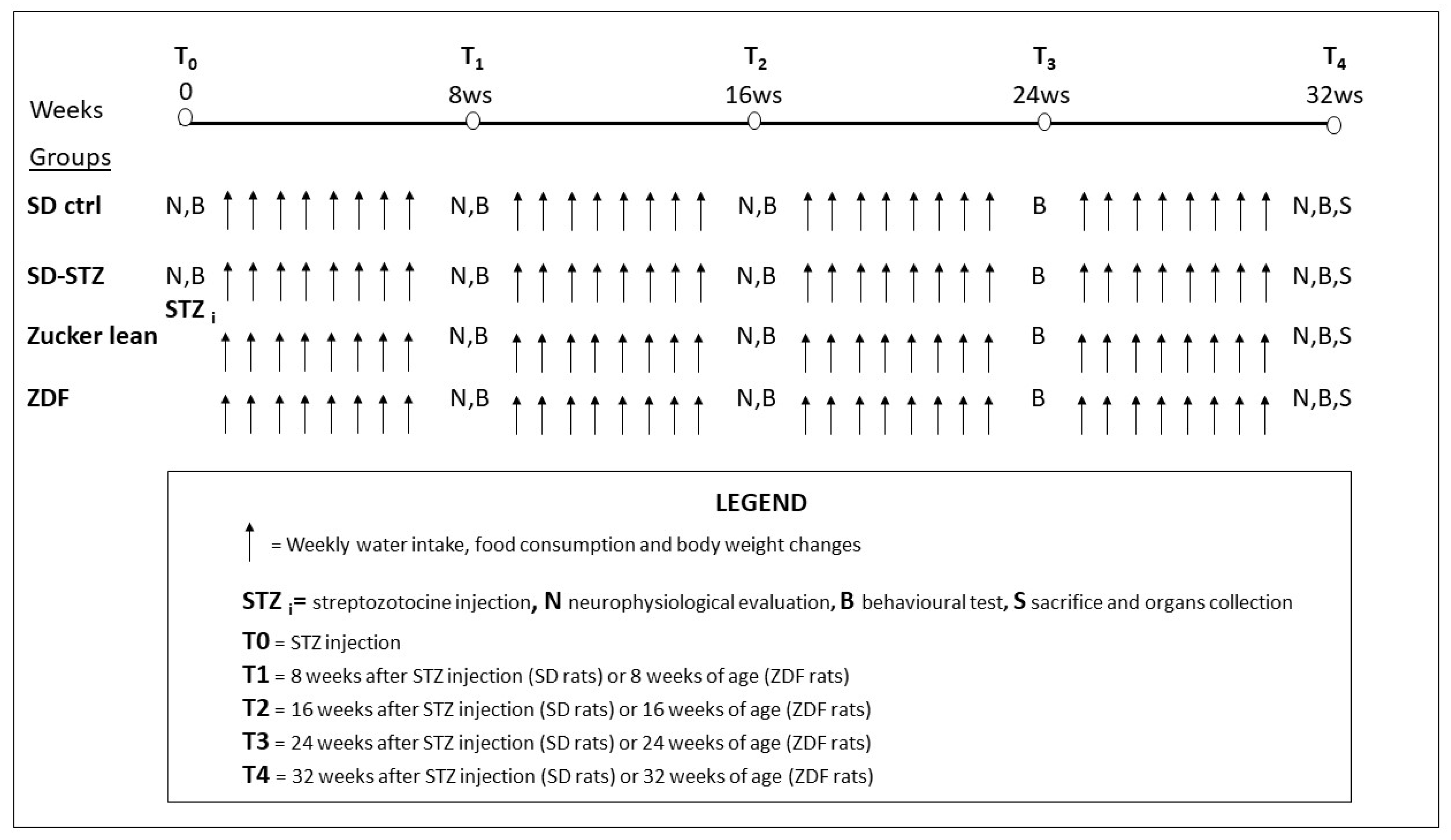
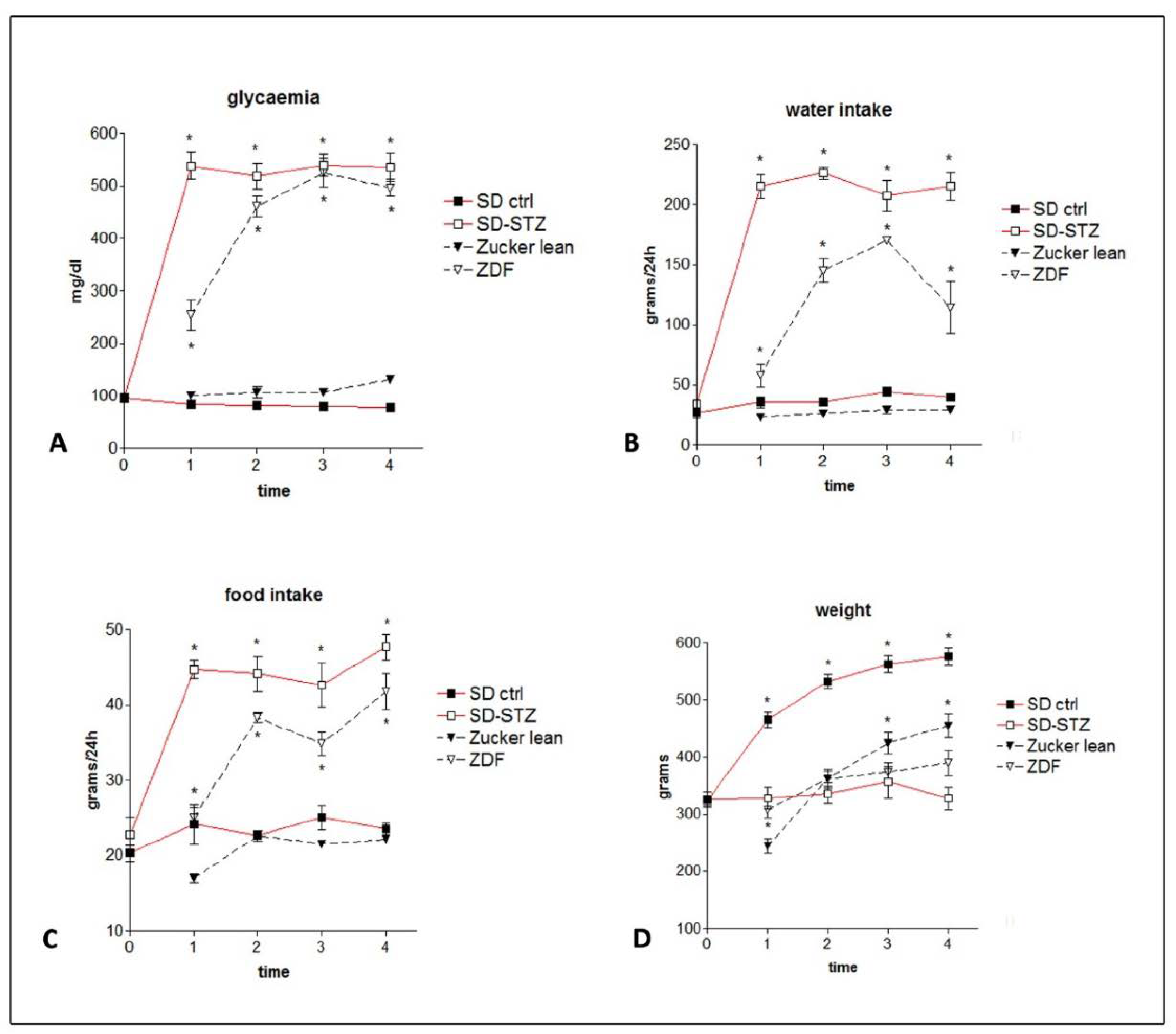
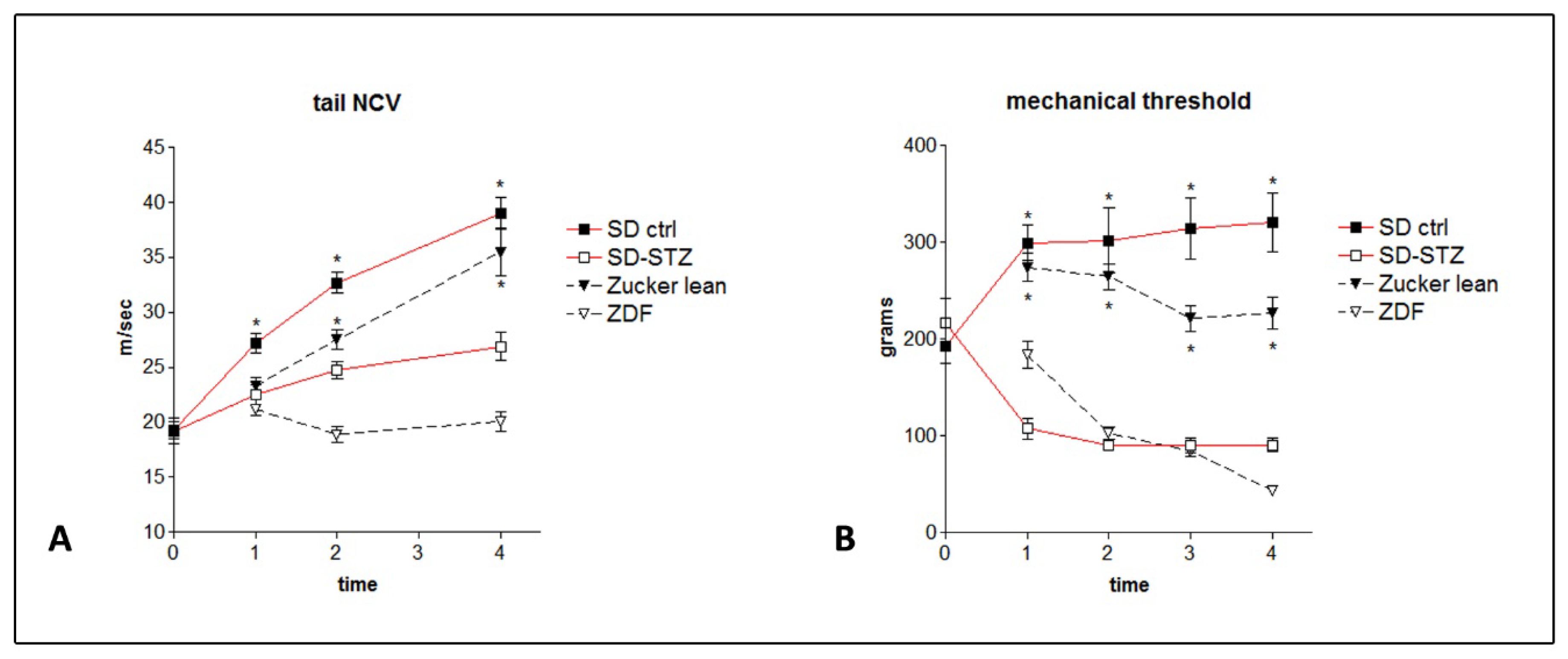
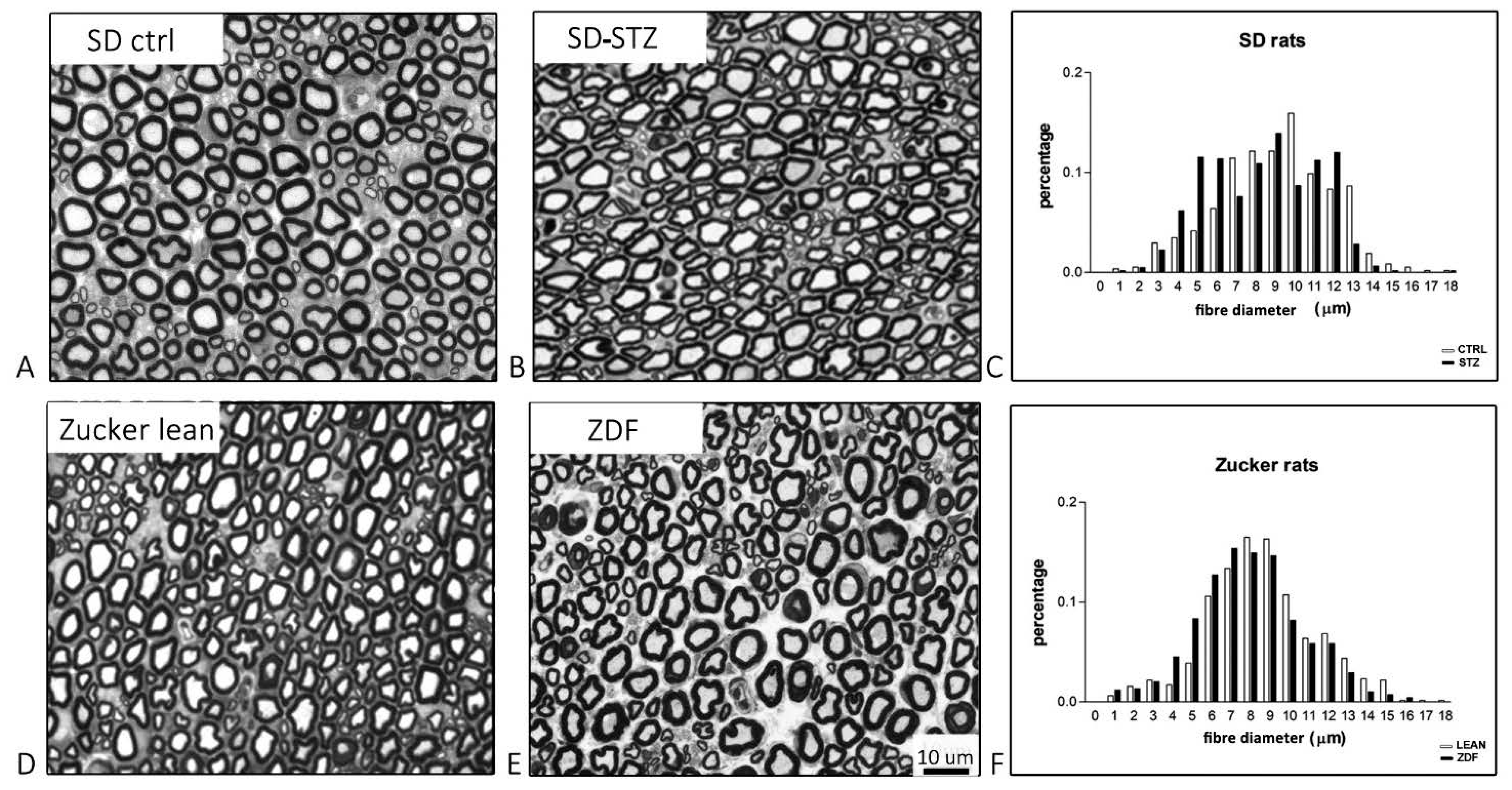
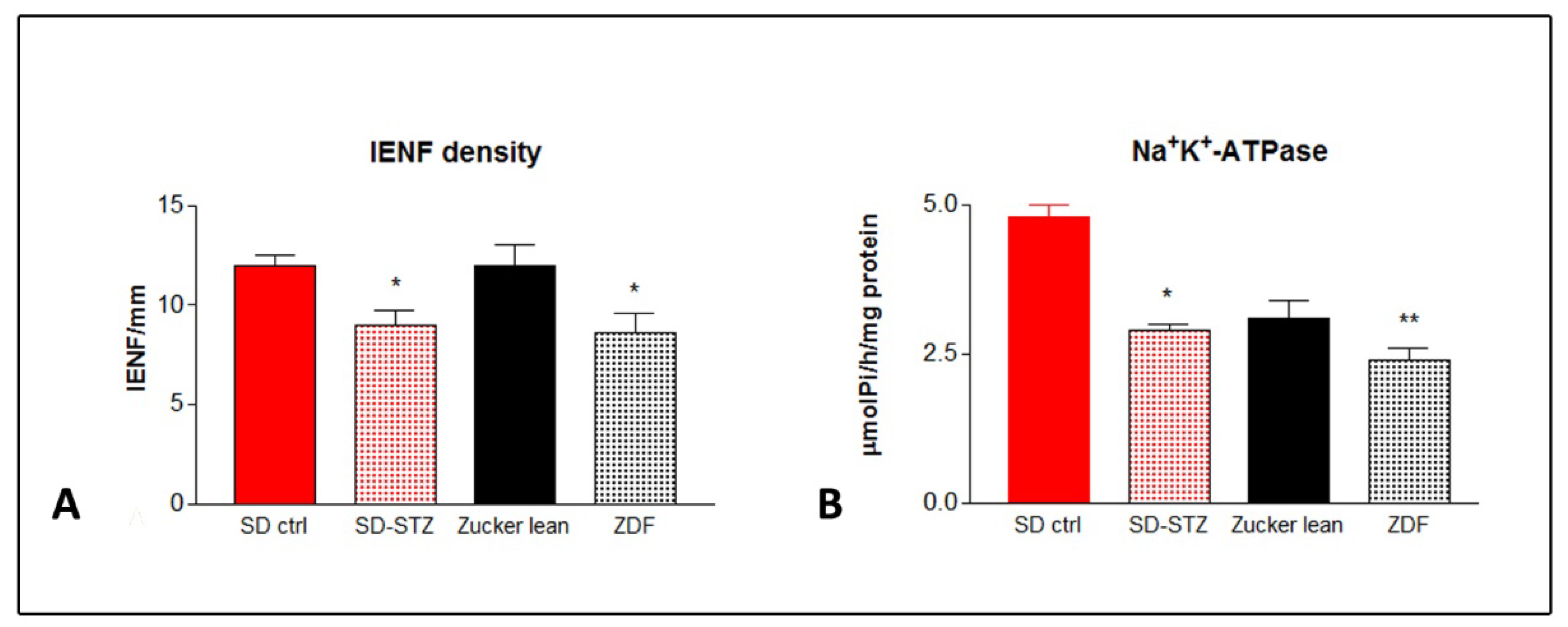
Disclaimer/Publisher’s Note: The statements, opinions and data contained in all publications are solely those of the individual author(s) and contributor(s) and not of MDPI and/or the editor(s). MDPI and/or the editor(s) disclaim responsibility for any injury to people or property resulting from any ideas, methods, instructions or products referred to in the content. |
© 2022 by the authors. Licensee MDPI, Basel, Switzerland. This article is an open access article distributed under the terms and conditions of the Creative Commons Attribution (CC BY) license (https://creativecommons.org/licenses/by/4.0/).
Share and Cite
Canta, A.; Carozzi, V.A.; Chiorazzi, A.; Meregalli, C.; Oggioni, N.; Rodriguez-Menendez, V.; Sala, B.; Melcangi, R.C.; Giatti, S.; Lombardi, R.; et al. Multimodal Comparison of Diabetic Neuropathy in Aged Streptozotocin-Treated Sprague–Dawley and Zucker Diabetic Fatty Rats. Biomedicines 2023, 11, 20. https://doi.org/10.3390/biomedicines11010020
Canta A, Carozzi VA, Chiorazzi A, Meregalli C, Oggioni N, Rodriguez-Menendez V, Sala B, Melcangi RC, Giatti S, Lombardi R, et al. Multimodal Comparison of Diabetic Neuropathy in Aged Streptozotocin-Treated Sprague–Dawley and Zucker Diabetic Fatty Rats. Biomedicines. 2023; 11(1):20. https://doi.org/10.3390/biomedicines11010020
Chicago/Turabian StyleCanta, Annalisa, Valentina A. Carozzi, Alessia Chiorazzi, Cristina Meregalli, Norberto Oggioni, Virginia Rodriguez-Menendez, Barbara Sala, Roberto Cosimo Melcangi, Silvia Giatti, Raffaella Lombardi, and et al. 2023. "Multimodal Comparison of Diabetic Neuropathy in Aged Streptozotocin-Treated Sprague–Dawley and Zucker Diabetic Fatty Rats" Biomedicines 11, no. 1: 20. https://doi.org/10.3390/biomedicines11010020
APA StyleCanta, A., Carozzi, V. A., Chiorazzi, A., Meregalli, C., Oggioni, N., Rodriguez-Menendez, V., Sala, B., Melcangi, R. C., Giatti, S., Lombardi, R., Bianchi, R., Marmiroli, P., & Cavaletti, G. (2023). Multimodal Comparison of Diabetic Neuropathy in Aged Streptozotocin-Treated Sprague–Dawley and Zucker Diabetic Fatty Rats. Biomedicines, 11(1), 20. https://doi.org/10.3390/biomedicines11010020







